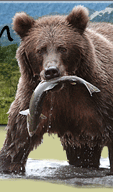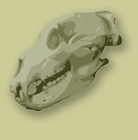 |
 |
 |
||||
 |
||||||
|
Return to Home Page
Bear Hunting Gear Clothing One of the most important aspects of preparing for a bear hunt in Alaska is getting the proper clothing. Our early Spring hunt (April 21 - May 2) and late Fall hunt (Oct. 25 - Nov. 6) are the most critical because they are the coldest. The temps can run between 20 - 30 degrees, and with a damp ocean wind blowing, the chill factor can be down close to zero. For the later spring hunt (May 4 - 15), the cold is not usually a problem and regular hunting gear is sufficient. The biggest concern is usually footwear. My guides and I always wear hip boots. I use the LaCrosse insulated boots. Some of my guides use Neo Sourdough Slippers or similar. These boots are not a tight fit and allow one or two pairs of heavy wool socks. Hip boots are difficult to climb in, so I recommend bringing a pair of good quality, insulated, waterproof hiking boots as well. You can carry them in the boat and change before a climb. Wool or fleece pants are nice to have on the colder hunts, as well as heavy, water-wicking underwear. Most hunters prefer heavy wool or fleece shirts and a heavy sweater over top. This combination is too heavy to climb in, but its nice for sitting on the beach and glassing. You can strip down for climbing. A lightweight fleece jacket is nice for climbing and a down filled or Hollofil jacket for traveling in the boat or sitting on the beach and glassing. Raingear is a must for hunting on Kodiak and we use 3/4 length rain parkas for glassing and lighter gear for climbing. Be sure to bring rain pants for climbing. I should point out that with all our years of hunting experience, we still get wet and cold at times. My dad used to say it builds character. For the hands, rubber gloves or mittens with a wool insert are great, along with a couple pairs of heavy wool gloves. Thinsulate gloves and mittens work well too. A cap with ear flaps, and you are ready to go hunting. Equipment binoculars (good quality) rifle/ammo soft gun case day pack spotting scope (your guide will carry one, but some hunters prefer their own) rangefinder (optional) camera headlamp water bottle Note: Most hunters bring too much gear. Since you will be flying into camp in a single-engine floatplane, try to pack as light as possible. A 50# bag per person, plus rifle, is usually plenty. We supply all sleeping accommodations, so don't bring a sleeping bag, pad, etc. Rifle: We get this question a lot: "What rifle caliber should I bring?". My answer is, bring the largest caliber you are comfortable with and shoot well. My father, Master Guide Park Munsey, used to say, "a good hit with a .308 is much more effective than a near miss with a .458". Our most common caliber used is the .375 H&H and is probably the best all-around caliber for these bears. Its what most of our guides carry. The .338 is also a popular caliber and is equally effective. Goat Hunting Gear Equipment List 2 changes clothes (lightweight fleece) Water-wicking underwear Extra socks Down, Fleece or Hollofil jacket lightweight raingear Cap, gloves Hiking boots - waterproof, insulated, 8 - 12" high Frame Pack Trekking pole (not necessary, but some hunters like them) Binoculars Head lamp or flashlight Water bottle Personal items (toothbrush, meds, book, etc) rifle/shells goat permit (Area RG480), hunting license and goat tag (purchased online from Alaska Dept. of Fish & Game) Dry Bag for airdropping (less than 15" diameter), bright color such as yellow (Seal Line Baja Bag 40 is a good choice) We will airdrop the camp and any of the above items that can be dropped safely, and climb up to the camp the following day. So any items you wish to airdrop will need to fit in a rubber dry bag that needs to fit through a 16" chute. The plan will be to airdrop the camp on the plane that flies you out to camp, so you need to have your items already packed in a Dry Bag before flying out to camp. Anything that doesn’t get dropped, that you will need on the mountain, will have to be packed up the mountain. I usually try to drop all clothes and as many personal items as possible and just carry my rifle, binoculars and water bottle up the mountain. You can leave any extra items, such as extra clothes, at base camp. Keep in mind that anything you do drop will have to be packed back down, so keep it light. We will provide the following for this hunt: Tents (each person has a two-man tent) Sleeping bags/sleeping mats Food (freeze-dried and frozen meals) Spotting Scope Rangefinder Coverwhites Campons Emergency gear Satellite phone Temperatures on the mountain can be down below freezing at night, with the possibility of snow. We will plan to spend 2 - 3 nights on the mountain and 3 - 4 nights at base camp. Deer Hunting Gear Equipment List Rifle w/ammo (2 boxes) Shotgun w/steel shot (if you wish to duck hunt) Rain gear (good quality and lightweight for walking and hiking) Waterproof hiking boots (insulated) Lightweight layered fleece outerwear (for walking and hiking) Heavy jacket (for boat travel and duck hunting) Lightweight gloves and heavy gloves Heavy wool socks Binoculars Day pack Water bottle Headlamp Optional: rangefinder, trekking pole Note: A November deer hunt on Kodiak can be very cold. Temps in the teens and 20's are common, with wind and/or snow. Its important to bring lightweight clothes you can climb in and heavier outerwear you can put on while stopping and glassing. Also, heavier outerwear is needed for duck hunting or boat travel. We have all licenses and tags in camp, except Federal Duck Stamps. Be sure to purchase one beforehand if you wish to duck hunt. |
|
Copyright 2012





